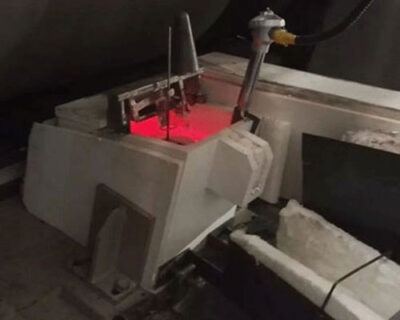Carbon gray streak is a kind of surface segregation phenomenon, the difference in deformation and plasticity of segregated parts after rolling. The stripes on the surface are regularly arranged, and the pattern is black after being etched by high-concentration acid, with no obvious changes in the grain structure. This kind of streaks often appear in the production of alloys, and most of them are on the lower surface and edges of the strip.
Main Reason for Carbon Gray Streak Formation
(1) The liquid cavity becomes deeper when the casting-rolling zone is too long. The slab is not easy to form when it is just out of the slab, and it is subjected to the rolling force to form a shearing force. The temperature of the newly crystallized metal layer in the inner deformation zone is relatively high, and there is no resistance behind the liquid cavity. When the shearing force exceeds the rigidly solidified metal When the shear strength is high, the low-strength intergranular is easy to pull apart, deform, and produce post-slip. The high-component alloy first flows in and fills, each forming a large amount of eutectic structure, causing segregation.
(2) Due to the nature of the alloy, the crystallization interval is large and the specific gravity is large, and the specific gravity segregation is likely to occur on the lower surface of the blank.
(3) The gap between the casting nozzle and the roll is large, the surface tension radius of the molten aluminum is large, and the resistance to pressure changes is reduced; in the liquid phase area, the molten aluminum is prone to oxidation when contacted with air. As the oxide thickness increases, it is bound to affect the aluminum Liquid flow stability.
(4) A small number of pure aluminum blanks occasionally appear due to the small roll diameter, roll temperature and flame spray concentration changes.

Carbon Gray Streak Treatment Measures
(1) Ensure that the casting nozzle is straight before the vertical plate, and adjust the relative position of the casting nozzle and the roll, the speed of the cast-rolling strip, the length of the casting-rolling zone and the cooling water temperature, and other process parameters.
(2) Control the temperature of the roll surface, the gap between the casting nozzle and the roll, and the depth of the liquid cavity during the production process, and control the gap between the casting nozzle and the roll within the range of roll bounce, deformation, and thermal deformation of the casting nozzle by 0.2-0.3mm, and adjust the flame spray size Suitable.
(3) If necessary, use the method of breaking the strip to break the oxide film at the front of the casting nozzle and eliminate the carbon gray streaks. Broken belt processing has certain risks. It is required that the liquid level of the launder and the front box should be as low as possible to be consistent, and the minimum speed of the rolling mill is controlled just right to have obvious effects.

